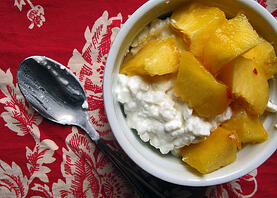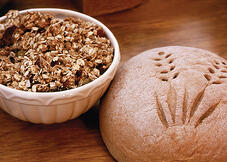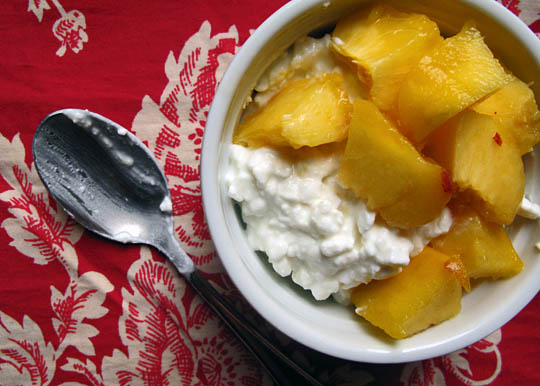STRONG BONES, STRONG BODY
We tend to focus on body weight, being tone, physical endurance, strength, and the mechanism carbohydrates and protein play in being athletic. We work hard and within a matter of time these attributes can be achieved. Unfortunately, bone health often falls by the wayside and this is a matter that needs timely attention. According to the National Institute of Arthritis and Musculoskeletal and Skin Diseases, by the age of 18 in girls and by the age of 20 in boys, 90% of peak bone mass is already acquired. The bone is a matrix of bone cells woven within a web of primarily calcium and phosphorus and will continue to grow its last bit up until the age of 30 years. At this the bone has essentially reached its maximum strength and density and will only deplete itself in strength from this point on. Despite this dismal fact, all hope is not lost! It is never too late to improve your bone health with a little assistance from healthy habits including diet and exercise!
Sure, strong bones sound like a good idea, but why is it so important to you? Weak bones can lead to osteoporosis—a major public health threat! It is a silent disease, meaning it develops under the radar often without any evident symptoms. So typically you don’t know you have it until an unfortunate event, such as breaking a bone happens which prompts you to get an x-ray. It is characterized by porous bone which is fragile, frail, and easy to break and can strike at any age. It leads to risk of fracture, pain, depression, loss of height, isolation, immobility, inability to stand, hospitalization, fear of falling, moving to nursing homes, increased risk of death in elderly, and costs America at least 18 billion dollars a year alone on healthcare for fractures resulting from osteoporosis.
As with anything, there are some factors that put you at risk for this disease that are out of our control including being a female, Caucasian, Asian, of a small frame and or slender body type, genetic predisposition, and older in age. This is precisely why it is important that we focus on the slew of risk factors that we do have a hand in! Of primary concern is low calcium and vitamin D intake, excessive alcohol or caffeine intake, history of anorexia or being underweight, as well as smoking and physical inactivity.
CALCI-YUM!
 We should all be saying yum to calcium…and for many reasons! It is literally the building block of the bone and is what give the bone strength and its hardness. It is also found in the blood and plays a major role in controlling blood pressure, blood clotting, muscle movement (including the heart!), and nerve function among other things. If we do not consume enough calcium through our diet we cannot maintain the levels in our blood necessary for function. The body is smart though and won’t let blood levels drop to such a level so it compensates by taking calcium from the bone. This is how our bones become weakened. You can find sources of calcium from dairy such as milk, yogurt, cheese, or pudding and non dairy sources too including spinach, broccoli, sardines, fortified OJ, and soy, rice, or lactaid milk.
We should all be saying yum to calcium…and for many reasons! It is literally the building block of the bone and is what give the bone strength and its hardness. It is also found in the blood and plays a major role in controlling blood pressure, blood clotting, muscle movement (including the heart!), and nerve function among other things. If we do not consume enough calcium through our diet we cannot maintain the levels in our blood necessary for function. The body is smart though and won’t let blood levels drop to such a level so it compensates by taking calcium from the bone. This is how our bones become weakened. You can find sources of calcium from dairy such as milk, yogurt, cheese, or pudding and non dairy sources too including spinach, broccoli, sardines, fortified OJ, and soy, rice, or lactaid milk.
CALCIUM’S SIDEKICK
Vitamin D is also significant to bone health and an endless amount of functions as there are vitamin D receptors in essentially every cell of the body. Such functions include aiding in calcium absorption, those of the immune system, and those controlling inflammation. When the body is deficient in vitamin D the absorption of calcium from the gut to the blood is no longer efficient. A diminished amount of calcium is then provided to the blood for function and the building of bone is again impaired. Vitamin D can be found in cheese, margarine, butter, fortified milk, and fatty fish. This biggest contributor to vitamin D in the body though is not from food, but from the sunlight! When the sun hits our skin we actually have the ability to make our own vitamin D. Just about 15 minutes in the sun (without sunscreen) having your face and arms exposed is a great way to get your daily needs!
HEALTHY HABITS
Other habits to hone in on include your alcohol and caffeine  intake, smoking habits, and physical activity. Alcohol disrupts calcium balance, vitamin D production, and hormones that affect calcium stores and promote bone forming cells. So women should limit themselves to 1 drink/day and men 1-2 drinks/day. Limit your caffeine as well as it disturbs calcium absorption. Nicotine and the chemicals in cigarettes also have a negative impact on bone health and make bone beneficial exercise more difficult! Weight-bearing exercise requires the bones and muscles to work against gravity. This stress placed on the bone tells the body to make them stronger so they can withstand the force placed on the bone. Such exercise includes jogging, jumping rope, basketball, weight lifting, or stair climbing among other activities. If you already have osteoporosis, try low impact exercise such as working on an elliptical or taking your dog for a walk. Exercise at least 30 minutes a day for adults and 60 minutes a day for children most, if not all, days of the week.
intake, smoking habits, and physical activity. Alcohol disrupts calcium balance, vitamin D production, and hormones that affect calcium stores and promote bone forming cells. So women should limit themselves to 1 drink/day and men 1-2 drinks/day. Limit your caffeine as well as it disturbs calcium absorption. Nicotine and the chemicals in cigarettes also have a negative impact on bone health and make bone beneficial exercise more difficult! Weight-bearing exercise requires the bones and muscles to work against gravity. This stress placed on the bone tells the body to make them stronger so they can withstand the force placed on the bone. Such exercise includes jogging, jumping rope, basketball, weight lifting, or stair climbing among other activities. If you already have osteoporosis, try low impact exercise such as working on an elliptical or taking your dog for a walk. Exercise at least 30 minutes a day for adults and 60 minutes a day for children most, if not all, days of the week.
DELICIOUS WAY TO WORK IT INTO YOUR DAY
Include Great Harvest’s whole grains to make calcium and vitamin D more fun to fit into your diet. Not to mention you are promoting overall health through the benefits of whole grains! Start with breakfast and pour a glass of fortified orange juice, splash low fat milk over your Cranberry Almond Oatmeal or mix Groovy Granola into some high protein Greek or vanilla yogurt. Make your family grilled cheese sandwiches on whole grain bread with broccoli and a yogurt dip on the side, and low fat pudding for dessert! Mix it up and make your meal tuna salad on a bed of spinach paired with a Great Harvest Onion Dill Rye roll, try mixing low fat milk with your Peet’s coffee to make a latte, or cottage cheese with peaches with a sprinkle of Great Harvest Granola later on for a for a midday snack! Combined with afternoon walks in the sunlight or playing with your kids in the park, you can work towards building the foundation for healthy bones and body for your children and work to maintain your own bones so you can continue to play hard and live fun!
D more fun to fit into your diet. Not to mention you are promoting overall health through the benefits of whole grains! Start with breakfast and pour a glass of fortified orange juice, splash low fat milk over your Cranberry Almond Oatmeal or mix Groovy Granola into some high protein Greek or vanilla yogurt. Make your family grilled cheese sandwiches on whole grain bread with broccoli and a yogurt dip on the side, and low fat pudding for dessert! Mix it up and make your meal tuna salad on a bed of spinach paired with a Great Harvest Onion Dill Rye roll, try mixing low fat milk with your Peet’s coffee to make a latte, or cottage cheese with peaches with a sprinkle of Great Harvest Granola later on for a for a midday snack! Combined with afternoon walks in the sunlight or playing with your kids in the park, you can work towards building the foundation for healthy bones and body for your children and work to maintain your own bones so you can continue to play hard and live fun!
What do you do to promote bone health?
References: NIH Osteoporosis and Related Bone Disease National Resource Center. National Institute of Arthritis and Musculoskeletal and Skin Diseases, January 2011. Web. 17 March 2011.




